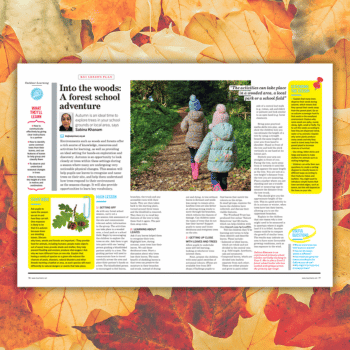Autumn is an ideal time to explore trees in your school grounds or local area. These autumn forest school activities by Sabina Khanam will get you started…
Environments such as woods and forests offer a rich source of knowledge, resources and activities for learning, as well as providing an ideal setting for hands-on exploration and discovery.
Autumn is an opportunity to look closely at trees within these settings during a season where many are undergoing very noticeable physical changes.
These autumn forest school activities will help pupils use leaves to recognise and name trees on their site, and help them understand how trees respond to their environment as the seasons change. It will also provide opportunities to learn key vocabulary.
Autumn forest school learning objectives
- Communicate effectively by giving clear instructions to a partner
- Identify some common trees from their leaves, and use features of leaves to help group and classify them
- Observe and understand seasonal changes in trees
- Measure the height of a tree in metres and centimetres
Starter activity
Ask pupils to name the season we are in and how they can tell. One response is likely to be that it is autumn because trees are shedding leaves.
Discuss why trees, woods and forests are important. (They provide food for animals, including humans; people make objects out of wood; trees provide shade and shelter; they help prevent flooding and erosion; produce vital oxygen.)
Ask why we have different trees on one site. Explain that having a variety of species on a given site reduces the chances of pests, diseases, natural disasters and other threats harming a habitat or area, as each species will react differently to natural dangers or events that take place.
Sabina Khanam is an experienced primary school teacher currently teaching in Year 2. She is also a Level 3 forest school leader who has worked with groups across the primary age range.











